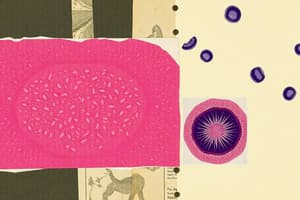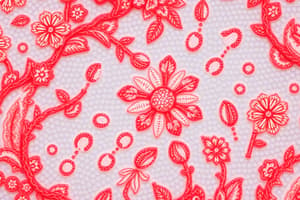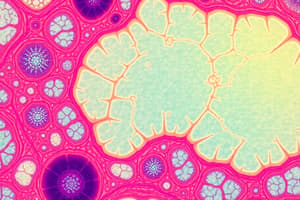Podcast
Questions and Answers
The Esophagus and lining of mouth are covered with:
The Esophagus and lining of mouth are covered with:
- Squamous epithelium (correct)
- Columnar epithelium
- Cuboidal epithelium
- Connective tissue
Two bones are connected together by:
Two bones are connected together by:
- Cartilage
- Tendons
- Plasma
- Ligaments (correct)
The fat storing connective tissue present under skin is:
The fat storing connective tissue present under skin is:
- Cartilage
- Areolar
- Adrenals
- Adipose (correct)
__________ is a striated and involuntary muscle.
__________ is a striated and involuntary muscle.
The matrix is fluid in which connective tissue?
The matrix is fluid in which connective tissue?
Assertion (A): Bone is a connective tissue which is very hard and rigid.
Reason (R): The matrix consists of calcium and phosphate.
Assertion (A): Bone is a connective tissue which is very hard and rigid. Reason (R): The matrix consists of calcium and phosphate.
Assertion (A): Epithelium have only a small amount of cementing material between them and almost no intercellular spaces.
Reason (R): Anything entering or leaving the body must cross at least one layer of epithelium.
Assertion (A): Epithelium have only a small amount of cementing material between them and almost no intercellular spaces. Reason (R): Anything entering or leaving the body must cross at least one layer of epithelium.
Assertion (A): Skin epithelial cells are arranged in a single layer.
Reason (R): Skin epithelium prevent wear and tear.
Assertion (A): Skin epithelial cells are arranged in a single layer. Reason (R): Skin epithelium prevent wear and tear.
Assertion (A): Two bones can be connected to each other by another type of connective tissue called the Ligaments.
Reason (R): This tissue is not elastic. It has considerably less strength.
Assertion (A): Two bones can be connected to each other by another type of connective tissue called the Ligaments. Reason (R): This tissue is not elastic. It has considerably less strength.
Assertion (A): The functional combination of nerve and muscle tissue is not fundamental to most animals.
Reason (R): This combination able animals to move rapidly in response to stimuli.
Assertion (A): The functional combination of nerve and muscle tissue is not fundamental to most animals. Reason (R): This combination able animals to move rapidly in response to stimuli.
Identify the tissue:
a) That has an ability to respond to stimuli.
b) Fat storing adipose tissue.
Identify the tissue: a) That has an ability to respond to stimuli. b) Fat storing adipose tissue.
Name the connective tissue that has hard matrix. What is its importance?
Name the connective tissue that has hard matrix. What is its importance?
Identify the tissue in the figure given below and write its function.
Identify the tissue in the figure given below and write its function.
Why are skeletal muscles called voluntary muscles?
Why are skeletal muscles called voluntary muscles?
What does a neuron consist off?
What does a neuron consist off?
Identify the tissue given in the figure. Mention the characteristic features of these cells. Specify the function of this tissue. Name the part of the body where these tissues are present.
Identify the tissue given in the figure. Mention the characteristic features of these cells. Specify the function of this tissue. Name the part of the body where these tissues are present.
Name the different components of the fluid connective tissue. Write two functions of the same.
Name the different components of the fluid connective tissue. Write two functions of the same.
Draw a well labelled diagram of a nerve cell and write down the composition of a nervous tissue.
Draw a well labelled diagram of a nerve cell and write down the composition of a nervous tissue.
Write down the location, structure and function of columnar epithelium tissue.
Write down the location, structure and function of columnar epithelium tissue.
Distinguish between bone and cartilage.
Distinguish between bone and cartilage.
What is the importance of ligament?
What is the importance of ligament?
Why is connective tissue known so?
Why is connective tissue known so?
What is a neuron? Write the structure and functions of a neuron.
What is a neuron? Write the structure and functions of a neuron.
Briefly describe striated and smooth muscles with their functions
Briefly describe striated and smooth muscles with their functions
With the help of labelled diagrams differentiate between striated muscles, unstriated muscles and cardia muscles?
With the help of labelled diagrams differentiate between striated muscles, unstriated muscles and cardia muscles?
Name the location and function of the muscle you can control.
Name the location and function of the muscle you can control.
Name the hard-working muscle that beats thousands of times a day. What are its characteristic features?
Name the hard-working muscle that beats thousands of times a day. What are its characteristic features?
Name the muscles which are under your control.
Name the muscles which are under your control.
This muscle is pointed at the ends, and has a prominent nucleus in the center of the cell.
This muscle is pointed at the ends, and has a prominent nucleus in the center of the cell.
Flashcards
Squamous Epithelium
Squamous Epithelium
A type of epithelial tissue characterized by flat, scale-like cells.
Columnar Epithelium
Columnar Epithelium
Epithelial tissue with tall, column-shaped cells.
Cuboidal Epithelium
Cuboidal Epithelium
Epithelial tissue consisting of cube-shaped cells.
Connective Tissue
Connective Tissue
Signup and view all the flashcards
Tendons
Tendons
Signup and view all the flashcards
Ligaments
Ligaments
Signup and view all the flashcards
Adipose Tissue
Adipose Tissue
Signup and view all the flashcards
Areolar Tissue
Areolar Tissue
Signup and view all the flashcards
Cardiac Muscle
Cardiac Muscle
Signup and view all the flashcards
Skeletal Muscle
Skeletal Muscle
Signup and view all the flashcards
Smooth Muscle
Smooth Muscle
Signup and view all the flashcards
Blood
Blood
Signup and view all the flashcards
Bone
Bone
Signup and view all the flashcards
Cartilage
Cartilage
Signup and view all the flashcards
Nervous Tissue
Nervous Tissue
Signup and view all the flashcards
Neurons
Neurons
Signup and view all the flashcards
Epithelial Tissue
Epithelial Tissue
Signup and view all the flashcards
Matrix
Matrix
Signup and view all the flashcards
Voluntary Muscle
Voluntary Muscle
Signup and view all the flashcards
Involuntary Muscle
Involuntary Muscle
Signup and view all the flashcards
Striated Muscle
Striated Muscle
Signup and view all the flashcards
Unstriated Muscle
Unstriated Muscle
Signup and view all the flashcards
Bone Framework
Bone Framework
Signup and view all the flashcards
What type of tissue lines the esophagus?
What type of tissue lines the esophagus?
Signup and view all the flashcards
What connects bones to bones?
What connects bones to bones?
Signup and view all the flashcards
What type of tissue stores fat?
What type of tissue stores fat?
Signup and view all the flashcards
What is the involuntary, striated muscle?
What is the involuntary, striated muscle?
Signup and view all the flashcards
Which tissue has a fluid matrix?
Which tissue has a fluid matrix?
Signup and view all the flashcards
What is the purpose of calcium and phosphate in bone?
What is the purpose of calcium and phosphate in bone?
Signup and view all the flashcards
Why is epithelium important for the body?
Why is epithelium important for the body?
Signup and view all the flashcards
Is skin made of a single layer of epithelial cells?
Is skin made of a single layer of epithelial cells?
Signup and view all the flashcards
What connects bones to muscles?
What connects bones to muscles?
Signup and view all the flashcards
Can ligaments stretch like elastic?
Can ligaments stretch like elastic?
Signup and view all the flashcards
Why is the combination of nerve and muscle tissue important for movement?
Why is the combination of nerve and muscle tissue important for movement?
Signup and view all the flashcards
What is a tissue that can respond to stimuli?
What is a tissue that can respond to stimuli?
Signup and view all the flashcards
What is the role of the matrix in connective tissue?
What is the role of the matrix in connective tissue?
Signup and view all the flashcards
What is the function of adipose tissue?
What is the function of adipose tissue?
Signup and view all the flashcards
What type of connective tissue has a hard matrix?
What type of connective tissue has a hard matrix?
Signup and view all the flashcards
What is the role of areolar connective tissue?
What is the role of areolar connective tissue?
Signup and view all the flashcards
Why are skeletal muscles called voluntary muscles?
Why are skeletal muscles called voluntary muscles?
Signup and view all the flashcards
What are the parts of a neuron?
What are the parts of a neuron?
Signup and view all the flashcards
What is the function of the tissue shown in the figure?
What is the function of the tissue shown in the figure?
Signup and view all the flashcards
What are the components of fluid connective tissue?
What are the components of fluid connective tissue?
Signup and view all the flashcards
Where are skeletal muscles found?
Where are skeletal muscles found?
Signup and view all the flashcards
What is the function of smooth muscle in the body?
What is the function of smooth muscle in the body?
Signup and view all the flashcards
How do skeletal, smooth, and cardiac muscles differ?
How do skeletal, smooth, and cardiac muscles differ?
Signup and view all the flashcards
Draw a neuron and describe its composition.
Draw a neuron and describe its composition.
Signup and view all the flashcards
What is the structure and function of columnar epithelium?
What is the structure and function of columnar epithelium?
Signup and view all the flashcards
What is a main distinction between bone and cartilage?
What is a main distinction between bone and cartilage?
Signup and view all the flashcards
Why are ligaments important?
Why are ligaments important?
Signup and view all the flashcards
Why is connective tissue named as such?
Why is connective tissue named as such?
Signup and view all the flashcards
What is a neuron?
What is a neuron?
Signup and view all the flashcards
Describe the structure and functions of a neuron.
Describe the structure and functions of a neuron.
Signup and view all the flashcards
What are the types of muscles?
What are the types of muscles?
Signup and view all the flashcards
How are striated and smooth muscles different?
How are striated and smooth muscles different?
Signup and view all the flashcards
What are the muscles that you can control?
What are the muscles that you can control?
Signup and view all the flashcards
What is the heart muscle called and what are its features?
What is the heart muscle called and what are its features?
Signup and view all the flashcards
What is the most efficient muscle in your body?
What is the most efficient muscle in your body?
Signup and view all the flashcards
What type of muscle is pointed at the ends and has a prominent nucleus?
What type of muscle is pointed at the ends and has a prominent nucleus?
Signup and view all the flashcards
Study Notes
Worksheet 4 - Animal Tissues
-
Worksheet Topic: Animal Tissues, Objective Type Questions
-
Question 1: The lining of the esophagus and mouth is covered by squamous epithelium.
-
Question 2: Two bones are connected by ligaments.
-
Question 3: Adipose tissue stores fat beneath the skin.
-
Question 4: Cardiac muscle is a striated and involuntary muscle.
-
Question 5: The matrix of blood is fluid.
Worksheet 4 - Animal Tissues (Continued)
- Questions 6-10 (Assertion & Reason): The document provides assertion and reason pairs to test student knowledge on tissues. These will need to be analyzed individually for a complete answer.
Short Answer Type Questions (2 Marks)
-
Question 11 (a): Nervous tissue can respond to stimuli
-
Question 11 (b): Adipose tissue stores fat
-
Question 12: Bone is a connective tissue with a hard matrix; its importance is structural support and protection.
-
Question 13: The image describes connective tissue.
-
Question 14: Skeletal muscles are called voluntary because they are consciously controlled.
-
Question 15: A neuron consists of a cell body, dendrites, and an axon.
Short Answer Type Questions (3 Marks)
-
Question 16: This section asks for identification, cell characteristics, function, and location. Expect a detailed answer.
-
Question 17: Fluid connective tissue components: blood. Functions: transport of oxygen, nutrients; defense against infection.
-
Question 18: The student is expected to tabulate descriptions of skeletal muscles, smooth muscles, and cardiac muscles. Expect a detailed table.
-
Question 19: Diagram of a nerve cell and its composition.
-
Question 20: Description and information on the columnar epithelium tissue.
Long Answer Type Questions (5 Marks)
-
Question 21 (i): Distinguishing characteristics of bone and cartilage will be important. Expect a detailed answer.
-
Question 21 (ii): Importance of ligaments will be included.
-
Question 21 (iii): The reasons connective tissues are important in biological systems will be covered.
-
Question 22: Definition, structure, and functions of a neuron will be tested.
-
Question 23: A detailed description of striated and smooth muscles with their functions.
-
Question 24: Diagrams are needed to differentiate between different muscle types.
Case Study-Based Questions
- Question 25: Location, function, and characteristics of various muscle types are assessed.
Studying That Suits You
Use AI to generate personalized quizzes and flashcards to suit your learning preferences.




